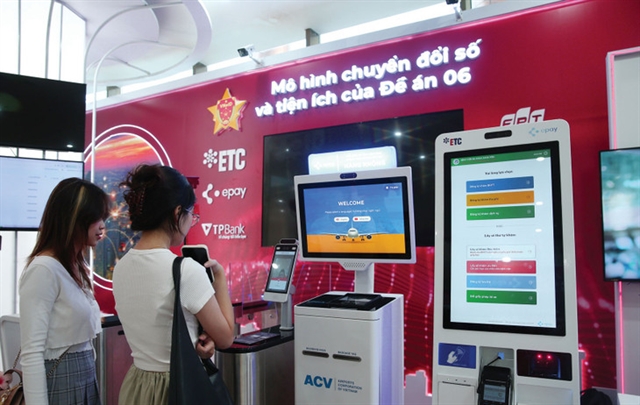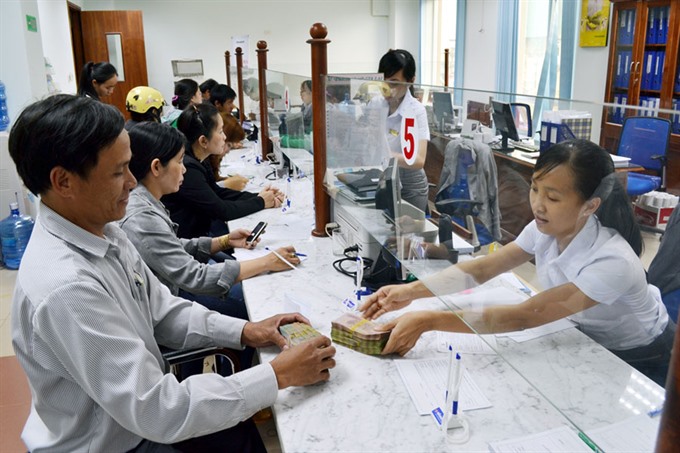 Business Beat
Business Beat

The State Bank of Việt Nam (SBV) withdrew a total VNĐ18.87 trillion (nearly US$829 million) from the market in the week of November 26-31.
 |
| Analysts from Saigon Securities Inc said the interest rates on the inter-bank market had remained steady for rather long but have been on an upward trend since October. – Photo vietcombank.com.vn |
by Thiên Lý
The State Bank of Việt Nam (SBV) withdrew a total VNĐ18.87 trillion (nearly US$829 million) from the market in the week of November 26-31.
That was the first week SBV net-withdrew money from the market after it had net-pumped a total VNĐ856.65 trillion the previous three weeks to support liquidity in the banking system.
The liquidity in the banking system is clearly not as abundant as it was earlier.
Interest rates on bank loans were also up significantly, especially for short-term loans.
Analysts from Saigon Securities Inc said the interest rates on the inter-bank market had remained steady for rather long but have been on an upward trend since October.
Interest rates for overnight ranged from 4.7 per cent to 4.9 per cent in November and reached the five-year high of 4.96 per cent.
Meanwhile, the interest rate for three-month loans exceeded 5 per cent in November and is currently at 5.2 per cent – 30 percentage points lower than the interest rate limit for six-month deposits.
A BIDV executive told SSI analysts that on average one-week inter-bank interest rates had been 3.67 per cent in October, up 0.16 percentage points from the previous month and a whopping 2.71 percentage points higher than a year earlier.
Meanwhile, what have banks been doing about their liquidity situation?
They have got into a race to hike deposit interest rates.
On November 20 the Sài Gòn – Hà Nội Joint Stock Commercial Bank (SHB) increased interest rates on its deposits by 0.6 percentage points.
Việt Nam Prosperous Joint Stock Commercial Bank, or VPBank, has raised rates by 0.1 percentage point.
By late October the deposit interest rates of the three State-owned lenders, Vietcombank, Vietinbank and BIDV, had already been up 0.1-0.3 percentage points.
Analysts said the banking system’s liquidity is showing the first signs of a shortage.
Some bankers attributed the rising rates to the central bank’s determination to keep monetary policy tight to ensure inflation does not rear its head and to keep the đồng steady.
The SBV recently increased the coupon rate on seven-day and 14-day treasury bills by 0.25 percentage points to mop up capital from the market.
The disparity between deposit growth and credit growth is another reason, with the former being 0.5-0.7 percentage points lower than the latter in the last few months.
This disparity is expected to widen since the market’s demand for funds always spikes in the last few months of the year ahead of the peak New Year-Lunar New Year shopping season.
The increases in the inter-bank interest rates and deposit interest rates are causing concern, especially among businesses, about a possible hike in lending interest rates.
Analysts said a rise in lending interest rates is inevitable when deposit interest rates are increasing.
According to data from the General Statistics Office, construction companies saw an increase of 0.3 percentage points in their interest payments on bank loans in the third quarter of this year.
Competition drives consumer finance companies’ profits down
Việt Nam Prosperity Joint Stock Commercial Bank (VPBank)’s pre-tax profit in the third quarter was only VNĐ1.75 trillion ($76.04 million), a year-on-year decrease of 26.3 per cent.
This reversed a trend of high profit growth in recent years.
A spokesman for the lender attributed this to a decrease in the profit of its consumer finance subsidiary, FE Credit.
In the first nine months of the year VPBank’s pre-tax profit was VNĐ6.7 trillion ($291.7 million), in which FE Credit’s share was VNĐ2.2 trillion, or 33 per cent, much lower than last year’s 47 per cent.
In the past FE Credit was considered a “money machine” as it provided half of the bank’s profit.
A similar situation was also seen at HDBank’s finance arm HDSaiSon. Its pre-tax profit in the first nine months of the year was VNĐ821 billion, down 20 per cent from the same period last year.
Its contribution to HDBank’s profit declined from 45 per cent on average in the past to 21 per cent.
FE Credit and HDSaiSon are the biggest players in the Vietnamese consumer financial market, whose size StoxPlus estimates at VNĐ1 quadrillion ($43.5 billion) by 2019 and annual growth at 29 per cent.
According to Bảo Việt Securities Company, the net profit margin in the banking industry is only 2 per cent while it is 20 per cent in the consumer credit sector.
Besides the two major companies, there are now nearly 20 other consumer finance companies in the market. Among the newly-established ones are Mcredit, Viet Credit, Easy Credit (EVN Finance), and SHB Finance.
Besides domestic players, the market is also attracting foreign investors, who are coming in through acquisitions.
South Korea’s Shinhanbank bought Prudential’s finance arm and Lotte Card purchased Techcombank’s finance company.
But this is causing the pie to be carved up into smaller and smaller shares and driving profitability down, analysts said.
However, they also pointed out that Việt Nam’s economy and people’s incomes are growing steadily, which would keep demand for consumer credit strong in the foreseeable future.
This means more and more businesses would enter the industry, and the competition would only get fiercer, they said. — VNS